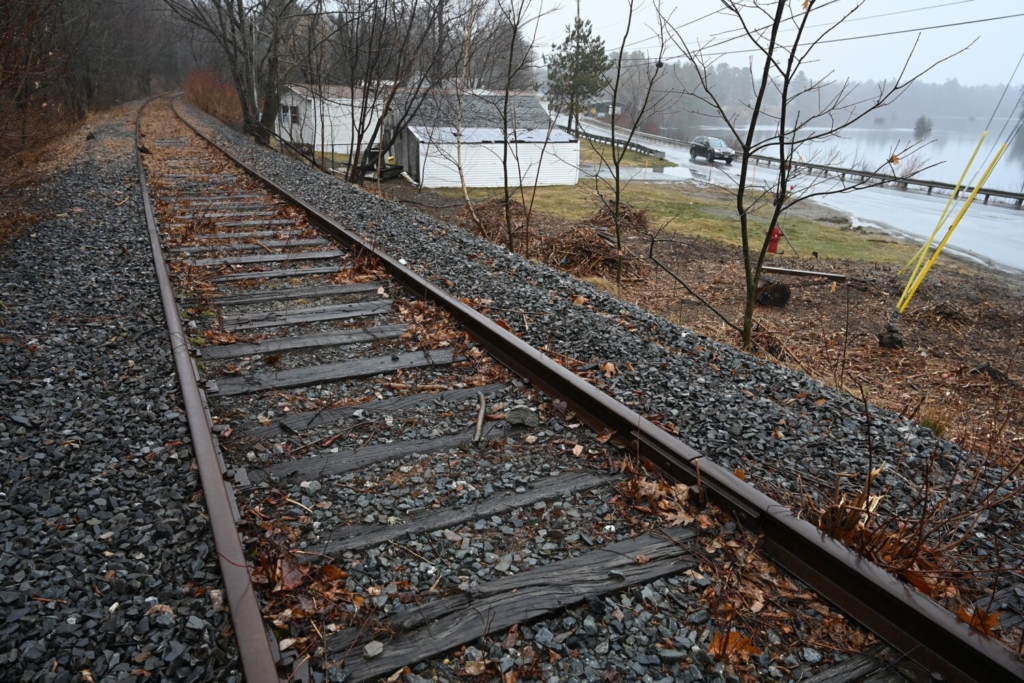Potential Threat to State-Owned Rail Lines in Maine
- Details
- Created: 08 December 2022 08 December 2022
 There is a new potential threat to rail use of State-owned rail lines in Maine. In 2021, the Maine legislature passed, and Governor Mills signed, a bill that permits governmental entities representing communities along a rail line owned by the State of Maine to petition Maine’s Commissioner of Transportation to appoint a rail corridor use advisory council to facilitate discussion, gather information and provide advice to the commissioner regarding the further use of that line.
There is a new potential threat to rail use of State-owned rail lines in Maine. In 2021, the Maine legislature passed, and Governor Mills signed, a bill that permits governmental entities representing communities along a rail line owned by the State of Maine to petition Maine’s Commissioner of Transportation to appoint a rail corridor use advisory council to facilitate discussion, gather information and provide advice to the commissioner regarding the further use of that line.
A report is then issued making recommendations on the likelihood, benefits, and costs of potential uses of that rail line including, but not limited to rail use, trail use or bikeways. The legislation (now at 23 M.R.S. § 75) requires the council to have 9-15 members and suggests, but does not require, that those members represent various departments of the State of Maine, as well as other interests. Two of the suggested categories are a representative of the Commissioner as well as a representative of an organization advocating for rail use or preservation. The other suggested membership categories do not include anyone who would inherently have any knowledge of rail issues, although the 15-member Portland to Auburn the council includes a representative of the parent company of the St. Lawrence & Atlantic Railroad, and both that council, as well as the 14-member Brunswick to Augusta council, include at least two other members who have advocated for passenger rail service in the past. MDOT provides staff and monetary support for the work of each council.
requires the council to have 9-15 members and suggests, but does not require, that those members represent various departments of the State of Maine, as well as other interests. Two of the suggested categories are a representative of the Commissioner as well as a representative of an organization advocating for rail use or preservation. The other suggested membership categories do not include anyone who would inherently have any knowledge of rail issues, although the 15-member Portland to Auburn the council includes a representative of the parent company of the St. Lawrence & Atlantic Railroad, and both that council, as well as the 14-member Brunswick to Augusta council, include at least two other members who have advocated for passenger rail service in the past. MDOT provides staff and monetary support for the work of each council.
The legislation requires each council to hold at least one public hearing at a location along the line and to issue a report within 9 months after its first meeting. The Commissioner is not required to take any action upon a report, although that might be politically difficult. Any non-rail use or dismantling of the line, however, can only move forward after legislative approval. Additionally, any non-rail use of the corridor is considered “interim” in nature, requiring the line to be preserved for future rail use if that once again becomes desirable.
Trail proponents are now using this new law to their advantage. At their instigation, the Commissioner has named three councils. One, which studied the Mountain Division between the Standish/Gorham border and Fryeburg, issued a report in May of this year recommending the removal of the rails and ballast from the line and replacing it with a paved trail. A second council is now in the process of considering the former St. Lawrence and Atlantic line between Portland and just south of Danville Junction in Auburn. That council has held several meetings and on December 5th held its public hearing in Cumberland. A third council is just starting to look at the Lower Road line between Brunswick and Augusta.
Trail proponents have proposed both trail with rail (where the trail is put in while the rails remain in place) and trail until rail (where the rail track and ballast are removed and replaced by the trail until a time when a return of rail service is deemed desirable, which is known as “rail banking”) options. The majority of those proponents, however, prefer the latter option of removing the track and ballast, since that ordinarily allows more speedy construction of the trail, possibly at less cost, than a trail with rail project, while also eliminating the possibility that rail use will interfere with the trail.
TrainRiders was represented by its legal counsel, F. Bruce Sleeper, at the December 5 public hearing on the Portland-Auburn line. Parties, including TrainRiders, each had 2 minutes to present their comments, with the ability to supplement them online. MDOT and the Town of Cumberland managed the meeting very well, with approximately 50-60 people speaking over a 2 1/2 hour period. Speakers were pretty evenly split between those who wanted the rail line preserved, either with or without a trail, and those who wanted it to be torn up and replaced by a trail. Council members will consider the presentations along with the other facts that they gather during their evaluation of the line.
These types of proceedings present several dangers to rail use in Maine:
Most obviously, removal of rail and ballast will immediately stop any current ability to provide rail service on a line.
Although thousands of miles of rail line have been rail banked throughout the United States, probably less than 100 miles have ever again be reconverted to rail use. Even without removal of rail and ballast, rail use was no longer needed on many of these lines and never again have been economically feasible. On the other hand, reconversion becomes very expensive once rail and ballast are removed, and this has sometimes made renewed rail use too costly to pursue even though it would otherwise have been economically justified. Finally, even though there may have been a legal right for rail renewal, in some instances the outcry from trail users, NIMBY’s, and others has made reconversion politically impossible even where economics might favor it.
The analysis used to evaluate the rail lines is not always even-handed. For example, the economic analysis of the Portland-Auburn line by an MDOT contractor indicates about 23% of users of a trail on that line would be non-local and that these non-local users would spend an average of $118 for food, lodging, and equipment on each daily trip on the trail, resulting in spending of $3.5-$5.3 million annually by those users for trail-related activities. That same study, however, includes only what rail passengers would spend on the train itself, resulting in an economic benefit of $114,000 to $130,000. Apparently, trial users get to eat, sleep and buy things whether or not they are on a trail they are on their trips, while rail passengers only do those things when on board their trains. Even if those passengers may primarily commuters be who would travel to the same destination by other means if passenger rail service was not available, still, it would only take 10 non-commuter passengers a day who spend $100 for one day at their destination to add $365,000 in localized spending annually to the figures used in the study. Rail passengers are also more likely than trail user to spend multiple days at their destinations increasing the rail passenger spending benefit even more.
The analysis also projects that, as a result of passenger rail service, only 37-58 new housing units would be developed around the proposed station site in Auburn, 17-26 units at Pineland, 85-172 units at Yarmouth. This compares to over 400 units developed close to the Brunswick station, several hundred in Saco, 250 in Dover, New Hampshire, 100 in Durham, and 100 in Exeter after the initiation of the Downeaster service. This does not include a 60-unit residential apartment building that has been approved, or an additional 40-50 that may shortly be proposed, for construction within a few hundred feet of the Freeport station. Although these Downeaster stations support local populations that exceed those in Pineland, they still give some indication that, except, perhaps, in Yarmouth, the study has undercounted the number of new housing units that should be anticipated as a result of passenger rail service on the Portland-Auburn line.
The study indicates that it will cost $274 million to upgrade the tracks between Portland and Auburn for passenger rail service. A substantial portion of that (perhaps as much as $60 million), however, would be for the cost of positive train control (PTC) along the line, something that is only required once there are more than 6 passenger rail round trips per day on the line.
This is not the time to consider ripping up the rails along the Portland to Auburn line. First, the legislature has also directed MDOT to prepare a separate study of the potential for passenger rail use between Portland and Lewiston-Auburn along this same line. That study will not be completed until sometime next year at the earliest and its findings will have a substantial impact upon what should happen on this line. Second, COVID has changed transportation needs and desires. At least some part of the information and projections prepared by an MDOT subcontractor is based upon Downeaster ridership figures from September 2021 through August 2022. While the Downeaster is currently at about the same ridership level as it had in 2019, such was not the case during a large part of the period from which these figures were taken.
What can you do about this? MDOT has an online site and click on the council that concerns you) that provides access to documents produced by each of the three councils been formed. Comments can be made using the “Contact Us” button on the sites for the Portland-Auburn and Brunswick-Augusta councils. Please comment, and get your fellow travelers to do so as well. Comments can range from something as simple as “Keep the rail” to a lengthy and, we hope, well-informed argument for that result. If you know anyone along either of these lines, get them to comment, at least if they support rail or carefully constructed rail with trail. Speaking to your State representatives and senators who represent areas along either line would be helpful (contacting other representatives and senators is now probably premature). You can be sure that trail proponents will speak up, and so should you.
F. Bruce Sleeper, TrainRiders/NE Legal Counsel
